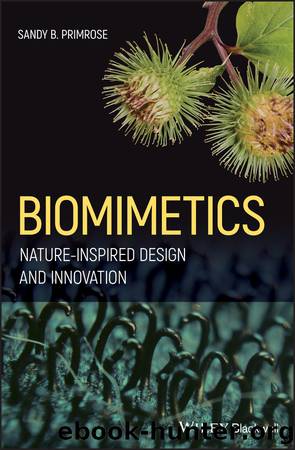Biomimetics by Primrose Sandy B.;

Author:Primrose, Sandy B.; [Primrose, Sandy B.]
Language: eng
Format: epub
Publisher: John Wiley & Sons, Incorporated
Published: 2020-06-22T00:00:00+00:00
Figure 4.9 The 2016â2017 Research Pavilion at the University of Stuttgart. The final pavilion after construction (top) and the method of construction by spinning fibres (bottom).
Source: Reproduced courtesy of ICD Institute for Computational Design and Construction, Faculty of Architecture and Urban Planning.
4.3 SelfâCleaning Surfaces
In the 1970s, Wilhelm Barthlott was the first botanist to study biological surfaces using scanning electron microscopy. His main interest was plant systematics and he was interested to know if the fascinating nanoâ and microâstructures that he saw could be used for classifying different plant taxa. To study these surface structures the leaves had to be prepared and cleaned. Barthlott soon realized that the leaves of some species were always clean whereas the surfaces of other species were always dirty. Surprisingly, there was a correlation between cleanliness and wettability. The smooth hydrophilic leaf surfaces were markedly dirty whereas the waterârepellent, hydrophobic leaf surfaces with microscale roughness were always clean. A publication detailing these observations went unnoticed outside of a small group of plant taxonomists.
In the 1990s, Barthlott1 and his student Christoph Neinhuis began a detailed investigation on the structural and functional basis of the selfâcleaning ability of certain plant leaves. They chose the lotus plant (Nelumbo nucifera) as their model because its leaves are always clean even though it grows in very muddy water. The cleanliness of the leaves in such an environment is so noticeable that the lotus has become a symbol of purity in many Eastern cultures. Examination of the surface of lotus leaves under a microscope revealed that the surface of the outer layer of cells (epidermis) is not smooth but is bumpy. This bumpy epidermis is covered by a thin layer of wax crystals that are waterârepellent (Figure 4.10). These two properties make the leaf superâhydrophobic (contact angle >140°) and selfâcleaning. Water falling onto the surface of the leaf forms nearly spherical beads that easily roll off; any dirt clings to the water droplet rather than to the waxy, bumpy surface of the leaf, and so is carried away. It is this complex surface coating that enables the leaf to be selfâcleaning, a phenomenon dubbed the âlotus effectâ (now trademarked as LotusâEffect®).
Download
This site does not store any files on its server. We only index and link to content provided by other sites. Please contact the content providers to delete copyright contents if any and email us, we'll remove relevant links or contents immediately.
Sapiens: A Brief History of Humankind by Yuval Noah Harari(14256)
The Tidewater Tales by John Barth(12609)
Mastermind: How to Think Like Sherlock Holmes by Maria Konnikova(7232)
Do No Harm Stories of Life, Death and Brain Surgery by Henry Marsh(6891)
The Thirst by Nesbo Jo(6832)
Why We Sleep: Unlocking the Power of Sleep and Dreams by Matthew Walker(6620)
Life 3.0: Being Human in the Age of Artificial Intelligence by Tegmark Max(5478)
Sapiens by Yuval Noah Harari(5295)
The Longevity Diet by Valter Longo(5021)
The Body: A Guide for Occupants by Bill Bryson(4976)
The Rules Do Not Apply by Ariel Levy(4866)
The Immortal Life of Henrietta Lacks by Rebecca Skloot(4528)
Animal Frequency by Melissa Alvarez(4399)
Why We Sleep by Matthew Walker(4362)
The Hacking of the American Mind by Robert H. Lustig(4319)
Yoga Anatomy by Kaminoff Leslie(4309)
All Creatures Great and Small by James Herriot(4233)
Double Down (Diary of a Wimpy Kid Book 11) by Jeff Kinney(4209)
Embedded Programming with Modern C++ Cookbook by Igor Viarheichyk(4107)
